Managing Millennials: 9 Strategies You Need to Know
Managing millennials can be a challenge. This article will give you nice strateg...

As a business manager, you have a lot of responsibilities: plan projects, create and execute marketing, coordinate deliveries, organize employees, and ensure the smooth operation of your company.
Without a doubt, one of the more difficult management tasks is scheduling your employees. Trying to create the perfect work schedule is often like trying to herd a kindle of kittens.
Fortunately, there are tools available that can help with this process. Some can even act as your own personal HR department and provide input to simplify schedule creation.
So what are the best work schedule maker tools for businesses in 2023 that you can look forward to trying? This article will answer that question.
With tools like pen and paper, word processors, spreadsheets, and calendar software, it can be extremely easy to make mistakes that can ruin the way your business operates. These mistakes may cost you time and money that could be better spent elsewhere.
That, in itself, may be a reason to avoid some of those older free work schedule maker options.
But, many of the more modern software solutions can actually help you eliminate mistakes from your staff rota with features such as artificial intelligence that monitors the parameters you set for your schedule and notifications that draw your attention to discrepancies.
Your 21st-century workforce needs a 21st-century solution to the hardcopy schedules of the past. Printed and photocopied calendars posted in the breakroom and handed out to each team member don’t cut it anymore.
Employees want to get the information from their digital devices, not from a piece of paper.
Modern scheduling solutions make it possible for your team members to access the necessary information easily anywhere and anytime they need it.
A big part of scheduling your employees is complying with local, state, and federal employment laws.
The location of your business plays a large role in determining what those specific laws will be because practices differ from state to state, county to county, and even city to city.
When you use a modern digital work schedule maker to abide by all the statutes, regulations, and ordinances — and communicate those rules to your team — you all but eliminate the risk of non-compliance in your area.
Labor costs are one of the largest expenses that your businesses may have to deal with.
But, with one of the more advanced free work schedule maker apps in place, your business may be able to gain more control over both the way your team works and the costs associated with this activity.
Controlling — and, in many cases, decreasing — labor costs can have a profound effect on your business’s bottom line and, by extension, its ultimate success.
You won’t get that control with pen and paper or a spreadsheet program, though.
Before the spread of the internet (and the spread of COVID-19) when data meant hardcopy and the majority of employees worked together in one central location, security was all about locking the file cabinet and keeping papers on the premises.
But, as connectivity continues to spread to all corners of our life, the distributed workforce becomes the new norm, and remote teams replace on-site teams, data security becomes more important than ever — not to mention more difficult to maintain.
The 21st-century workforce needs access to information and tools at all hours of the day and from both remote and on-site locations.
The top-of-the-line solutions include strong security built right in that helps ensure that files, documents, and other data stay out of the hands of unauthorized individuals while still being accessible to your team with just a few clicks or taps.
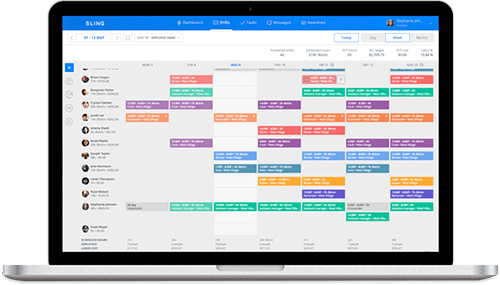
Source: GetSling.com
Sling is a schedule maker designed specifically with you, the busy manager, in mind. It combines the simplicity of a calendar view and the easy distribution of cloud-based technology with a whole host of other features that can make scheduling the easiest job you’ve got.
That makes Sling the best work schedule maker for your business.
Small and large businesses alike can enjoy streamlined scheduling for an unlimited number of employees thanks to Sling’s unique ability to copy schedules between days and weeks, or simply drag and drop shifts where you need them.
With Sling, you can even create recurring shifts that appear in the same place on your schedule every time.
Sling is packed with other intuitive tools — like employee and task color coding, advanced reports, and time-off notices. Sling even allows for notifying employees about no-shows and available shifts with advanced communication features and push notifications sent directly to their phones.
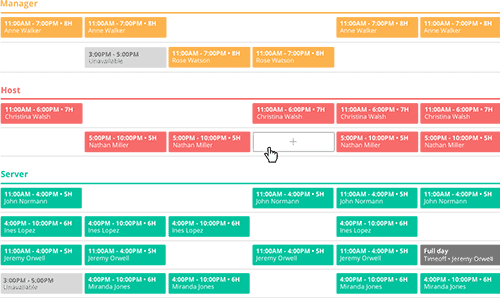
Source: GetSling.com
On top of all the tools dedicated to the scheduling process itself, Sling also acts as your own scheduling personal assistant. Sling will keep an eye on your work and notify you when you’ve unintentionally overlapped shifts or double-booked an employee.
This cuts down on the work you have to do after you create the schedule, such as making changes and sorting everything out. Sling makes it easy to get the schedule right the first time.
Sling comes with a 15-day free trial, and scheduling and other basic features are free for teams of up to 50 even beyond 15 days. You can get started by creating your free account here.
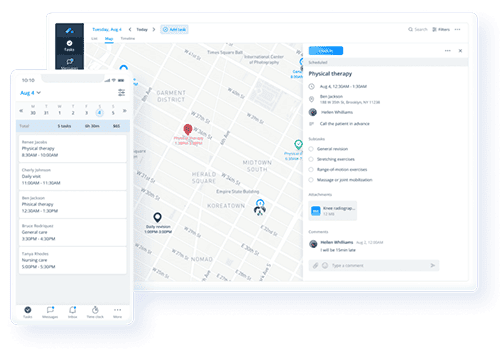
Source: TryInch.com
The Inch work schedule maker app can help both remote and on-site team members stay on task with a variety of features and tools, including:
With all of these features at hand, you’ll be better prepared to build an employee roster that helps your team perform at their best, day after day.
Third on our list is the most basic schedule maker of all: pen and paper. As basic as the pen-and-paper option is, it is the most difficult to use and really does nothing to make your life easier.
Yes, this method has been the go-to schedule maker for…well, a really long time. But that doesn’t mean it’s your best option. In fact, the pen-and-paper method is likely what gave scheduling the rotten reputation it currently holds.

For one thing, it’s not easy to distribute. Yes, you can post it in the break room or outside your office, but what’s to ensure that your employees will look at it with enough time to notify you of conflicts?
For another thing, a pen-and-paper schedule isn’t the easiest thing to change…and you know you’re likely going to need to make changes. Sure, you can have a form you fill in, but that’s still a significant amount of work that could be done away with by using more modern methods.
With the advent and spread of computers in the late 20th century, word processors like Microsoft Word and WordPerfect replaced pen and paper as the default schedule maker for many businesses. But that doesn’t mean it’s a better tool for the job — just a more modern tool.

Source: Microsoft.com
Many of the same problems still make the process difficult. You still have to create a form that is conducive to scheduling and easy for your employees to read. And have you ever tried to format something on a word processor and make it behave like you want it to? Sometimes, pen and paper is less frustrating.
Changes to the schedule might be a bit easier to make with a word processor because you don’t have to make a completely new form each time. But there’s still quite a bit of work involved in moving things around and getting shifts and employees where they should be.
You also still face the same challenges of distribution that make pen and paper so difficult. Sure, you now have the option of emailing your schedule to all employees simultaneously. But who’s to say that every employee will be able to open the schedule?
And who’s to say every employee even uses email? Many rely on social media instead.
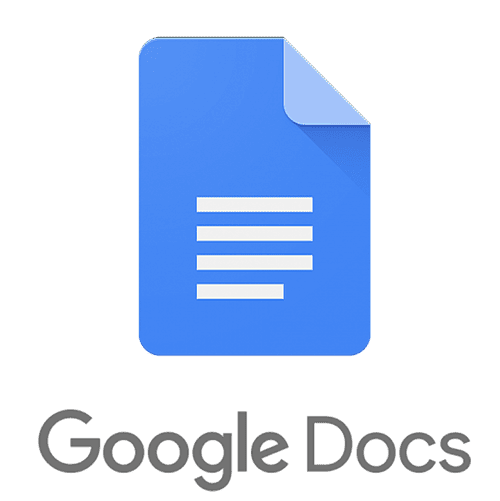
Source: Blog.Google.com
Cloud-based word processors, like Google Docs, are the 21st-century evolution of a 20th-century product. They are a step up from word processors of the past, but only a relatively small one. While these word processors solve one of the major issues involved in creating and distributing a schedule, many of the other issues remain.
The main advantage of using a cloud-based word processor as a schedule maker is the ease of distribution. You create your schedule online through your preferred internet browser, save it in the cloud, and then grant access to all employees by sending them a link.
Anyone can view the schedule anytime they want, making this method a more efficient way to get the schedule into everyone’s hands. This can make for a more productive team.
Ease of distribution aside, the difficulties that plagued the regular word processor still remain. You still have to struggle with formatting. And while making changes is somewhat streamlined because employees can leave notes regarding conflicts and trades, you still have to contend with making those changes work.
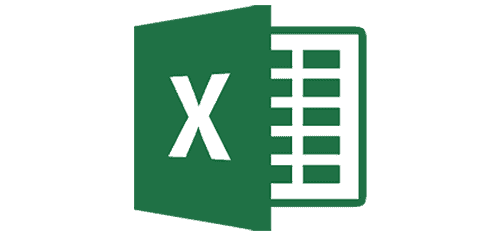
Source: Microsoft.com
Unlike word processors that start you out with a blank page, spreadsheet software, like Microsoft Excel, gives you rows and columns as your default format.
This in itself is a step up from both pen and paper and word processors because you no longer have to work so hard to create the columns that designate days and the boxes that designate shifts.
Spreadsheet software does this for you and makes the alteration and movement of those important pieces much, much easier. But while spreadsheet software is much more flexible as a schedule maker for businesses, it still suffers from a number of problems.
For one thing, spreadsheet software is still plagued by the distribution problems that both pen and paper and word processors struggle with. Should you print and post, hand out, or email everyone a copy? And once changes are needed (which they likely will be), which copy is the most recent?
It can be hard for employees to keep track. That introduces a confusion factor that can make the process all the more difficult.
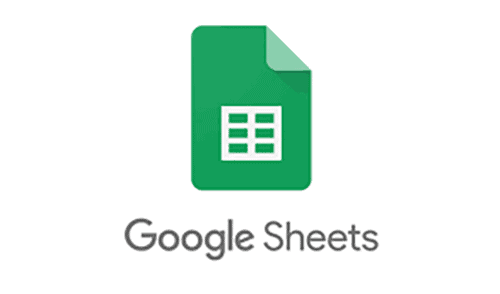
Source: Blog.Google.com
As with the word processors, using a spreadsheet app like Google Sheets online (i.e., in the cloud) streamlines the distribution process. That said, many other problems still remain.
It’s important to remember that spreadsheets were designed with database management and accounting in mind. The tools and the solutions they offer are geared toward those activities, not toward scheduling.
So while spreadsheets can be made to work for scheduling employees, they aren’t as powerful or as useful as other schedule makers.
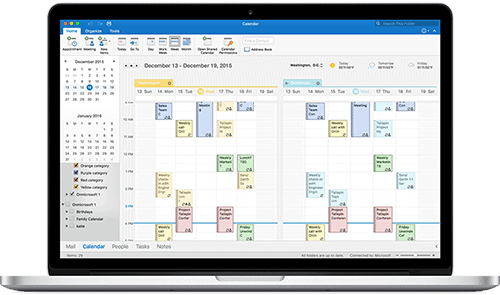
Calendar software, like Microsoft Outlook, can be a replacement for pen and paper, word processors, spreadsheets, and their cloud-based counterparts. Calendar software is more amenable to scheduling because it was created with time in mind.
Times, days, weeks, months, and even years are already present and can be manipulated with ease. In addition, creating shifts, which on most calendars would be like tasks or appointments, is usually as easy as clicking a time slot and labeling it accordingly.
So while calendar software is a step in the right direction, it still shouldn’t be classified as the best schedule maker for businesses. Calendar software like Microsoft Outlook was made for the use of a single individual.
In addition, calendar software wasn’t created with overlapping shifts and other complicated scheduling practices in mind. Remember, it was intended for one person who could only be in one place at a time.
Calendar software also faces the same distribution challenges that make native word processors and spreadsheet programs obsolete. That’s not to say that you can’t make them work. It’s just that there may be better solutions out there for employee scheduling.
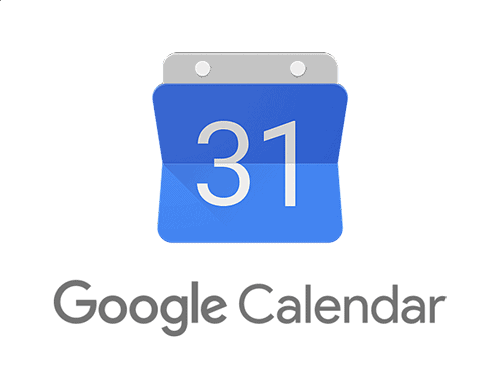
Source: Calendar.Google.com
Online calendar software, like Google Calendar, builds on the relative ease of offline calendar software as a schedule maker. These programs then take schedule creation to the next level by giving your schedule the power of cloud-based distribution.
Much like Google Docs and Google Sheets, Google Calendars are created online. You can then give permission to read or edit the document accordingly. Employees can view that schedule anytime, anywhere.
This makes collecting and making changes simpler because employees can leave notes in the document informing you of conflicts.
You will, of course, have to go back in and make the necessary changes, but you might also consider giving trusted employees permission to edit the schedule. That way, they can move their shifts to avoid conflicts and take some of the burden off your shoulders.

Source: Shiftyapp.com
Shifty is a simple app for small businesses and individuals that lets you schedule multiple employees amongst multiple shifts. You can even assign duties and tasks so your employees know what needs to be done during slow times.
This app may be more conducive to scheduling multiple shifts and multiple employees when compared to word processor and spreadsheet apps. For one thing, it’s meant for scheduling (as opposed to writing or database maintenance), so the view, interface, formatting, and all of its tools make that task easier.
It does, however, have the same distribution problems as the previous two apps. Schedules are distributed via email. That means you have to make sure everyone receives it even if they don’t have an email account.
Plus, you have to verify that everyone understands when changes are made because slightly different copies of the same schedule will exist. That distribution speedbump can make things more complicated than they need to be, but the time you’ll save just putting your schedule together will likely be significant.
Shifty won’t notify you when you’ve double-booked one of your employees. It won’t keep track of time-off requests, and it won’t offer suggestions to make the scheduling process easier.
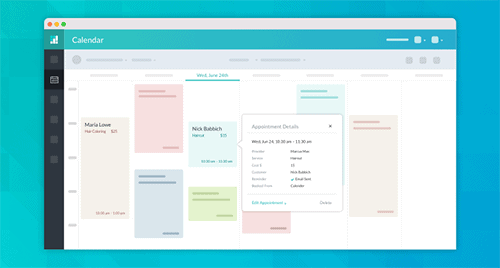
Source: Setmore.com
Setmore offers appointment scheduling through your browser, desktop/laptop, or mobile device. Use dropdown menus to pull together services, customers, and staffing from built-in listings and you’re there.
Need to reschedule? Drag and drop the appointment into a new timeslot. Setmore automatically sends out a reschedule notice to the customer and the staff member.
But, as you can see from the image above, Setmore is designed specifically for a single user to schedule their appointments. It wasn’t made to handle complicated shift scheduling for multiple employees.
You can make this app work for a team of three or more by scheduling several employees in one box. But if the schedule changes for some reason — illness, shift switch, or the like — you would have to change everything and start fresh. That may not be practical for a busy manager.
If you need to create a schedule for your restaurant, coffee shop, nursing staff, or hotel (just to name a few) to accommodate more than one employee, you’ll need something more powerful, like Sling.
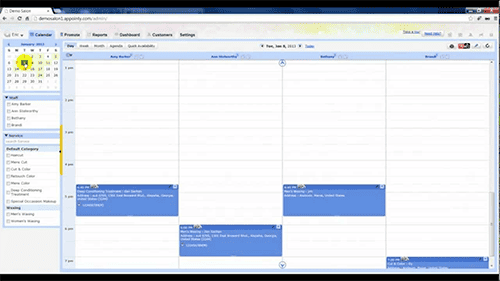
Source: Appointy.com
Don’t have your own website? Appointy provides a unique sub-domain you can use to create your own booking page. Appointy even creates a tab on your Facebook page that allows customers to schedule their next appointment on their own.
Appointy also gives you complete control over your schedule. You can:
As a schedule maker for a single individual, Appointy can be a decent solution. You can use multiple instances of Appointy to schedule more than one team member in your business, but those employees won’t see their teammates’ work time — they’ll only see their own schedule.
If you need to organize multiple employees or team members and have them display on a single schedule, Appointy isn’t the right tool for the job.
For more powerful scheduling tools, you need a schedule maker (like Sling) designed for multiple employees and multiple locations.
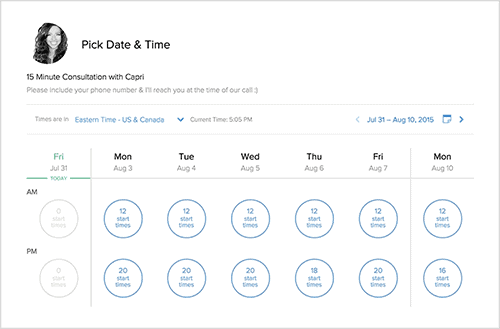
Source: Calendly.com
Calendly is an automated schedule maker that lets you program availability, share it with others (via a personalized link), and schedule directly to employee calendars. Customers can then pick a time and add it to your schedule. No emailing back and forth trying to find the right time.
Calendly is geared toward the individual user scheduling one appointment at a given time. You can schedule multiple individuals for the same time slot (as you would when building shifts), but the schedule itself will start to look cluttered and complicated.
To achieve the type of clear, concise, and easy-to-put-together schedule you’re looking for, you may want to consider a schedule maker like Sling.
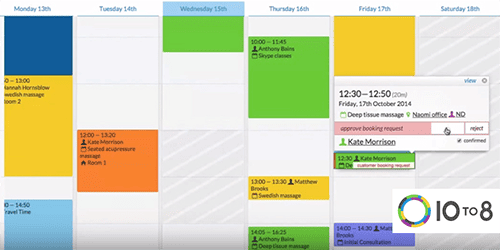
Source: 10to8.com
10 To 8 is designed to offer appointment booking, automatic syncing with your existing calendar (Outlook, Google, iCloud, etc.), and even automated email and text reminders so clients never miss appointments again.
If you’re a single user who needs to streamline how you set your appointments each day, 10 To 8 may be the solution. But if you need to schedule a team of two, three, five, or more, you’d be better served with a full-service team schedule maker like Sling.
10 To 8 won’t easily or conveniently accommodate complicated shift scheduling — although you can force it to work in a pinch.
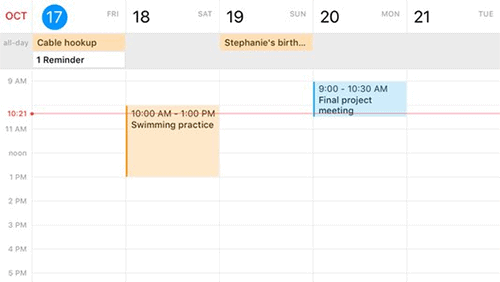
Source: Flexibits.com
Fantastical 2 (said like “FantastiCAL,” as in CALendar) is another work schedule maker that can relieve some of the stress of scheduling your team.
Like other scheduling tools, you can enter employees as “tasks” and color code each entry to set them apart from each other.
Team members can then view the schedule by day, week, or month and can even search the schedule to see past, present, and future events that apply to them.
While Fantastical 2 does have some powerful features (like Apple Watch support and 6 different languages), it wasn’t designed with a large team in mind.
Yes, you can force it to work for multiple employees and complex scheduling, but why go to the effort of pushing a square peg into a round hole? There are other software options that may fit your needs better.
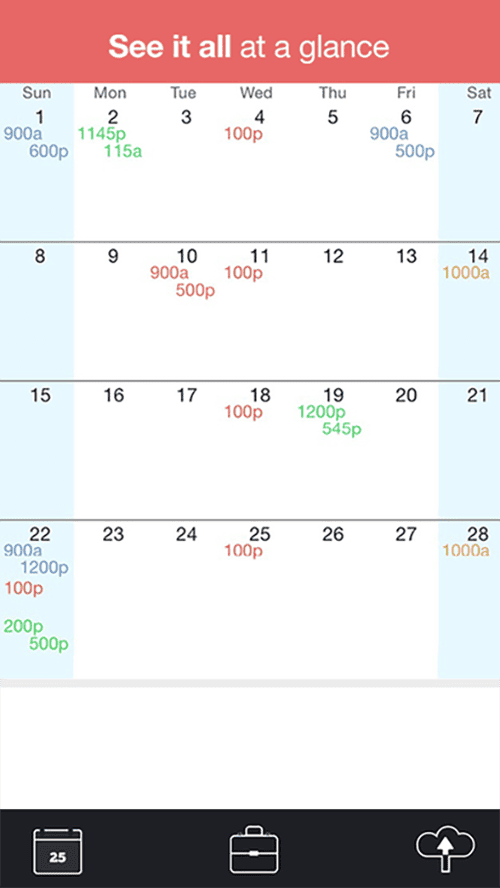
Source: Worktime.com
As the name implies, WorkTime is all about scheduling and tracking work time. This work schedule maker lets you create and track complex work schedules with ease. You can enter a shift and then view the entire week’s schedule all on one screen.
Professional-level features like unlimited jobs, alarms and notifications, and even schedule sharing via Facebook, Twitter, or email make this a useful app for scheduling your team. You can even add up hours worked and wages earned with WorkTime’s hours calculator.
But, like many of the other work schedule apps on this list, WorkTime was really only intended for a small team (1-3 employees).
On top of that, it doesn’t have any features to help you during the scheduling process — like built-in artificial intelligence, reminders, templates, and advanced communication features.
Really, only the first work schedule maker on this list — Sling — offers everything you need to do the job right.
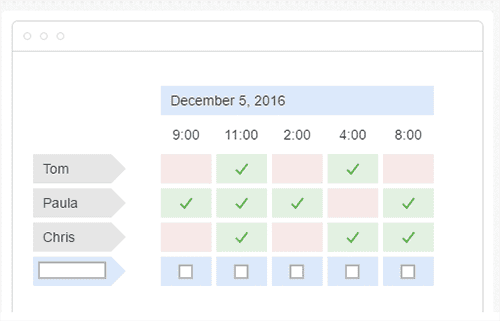
Source: Doodle.com
Like the previous entries in this list, Doodle is a simple scheduling app that can keep track of when your employees work. This app doesn’t offer as many features as other solutions, so multiple shifts and other complicated scheduling tasks may exceed its abilities.
But for a small business with only a few employees, this may be a nice transition from pen and paper (or spreadsheet) toward a more advanced — and better-suited — scheduling app.
When you create a schedule, you create a master document that everyone can view. When you need to make changes, you do so to the master copy. That way, when employees view the schedule link, they are always seeing the most up-to-date version.
As with the apps that precede it on this list, Doodle doesn’t provide suggestions, it doesn’t display overlapping shifts, and it doesn’t notify you when you’ve double-booked an employee or scheduled them during a requested time off.
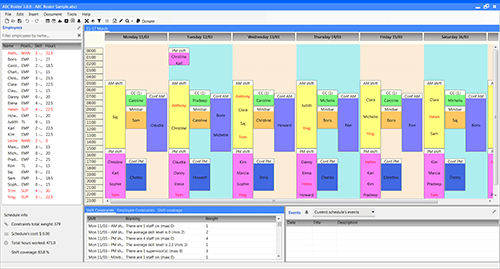
Source: Abc-roster.com
ABC Roster is a work schedule maker app designed to assist in the complex task of organizing your team’s shifts to make everything flow better.
The software was built for small businesses with a limited number of employees but has since expanded.
The main features of the app revolve around an interface that allows you to manage all aspects of scheduling — including employee availability, days off, leave, events, bookings, and more — from one screen.

While legacy work schedule maker solutions like pen and paper, word processors, spreadsheets, and calendar programs may have worked for your restaurant in the past, modern technology has made them all but obsolete.
Specially designed apps (like Sling) combine the simplicity of a calendar view and the easy distribution of cloud-based technology with a whole host of other features that can help streamline even the most complicated shifts and restaurant schedules.
And, you don’t have to spend an arm and a leg to use these digital solutions.
As you can see from this list, there are a number of free work schedule maker options out there that can help you move your restaurant into the 21st century.
But, don’t just settle for the first program that comes along. Look for a tool that will help you in other aspects of your job so that everything runs as smoothly as possible.

While many apps make the scheduling process simpler, only a handful, like Sling, actually provide tools that help you in all aspects of managing your restaurant, hotel, retail establishment, coffee shop, bar, or healthcare business.
Sling offers:
For more free resources to help you manage your business better, organize and schedule your team, and track and calculate labor costs, visit GetSling.com today.
This content is for informational purposes and is not intended as legal, tax, HR, or any other professional advice.
See Here For Last Updated Dates: Link
Schedule faster, communicate better, get things done.